Berkeley Castle: Difference between revisions
Created page with "{{Infobox castle |name=Berkeley Castle |village=Berkeley |county=Gloucestershire |picture=Berkeley Castle - geograph.org.uk - 1440403.jpg |picture caption=Berkeley Castle |os ..." |
m →top: ioe -> nhle, replaced: {{IoE|132188 → {{NHLE|1340692 |
||
| (One intermediate revision by one other user not shown) | |||
| Line 13: | Line 13: | ||
|website=[http://www.berkeley-castle.com/ Berkeley Castle] | |website=[http://www.berkeley-castle.com/ Berkeley Castle] | ||
}} | }} | ||
'''Berkeley Castle''' (historically sometimes spelt ''Berkley Castle'') is a castle in the town of [[Berkeley]], [[Gloucestershire]]. The castle's origins date back to the 11th century and it has been designated as a | '''Berkeley Castle''' (historically sometimes spelt ''Berkley Castle'') is a castle in the town of [[Berkeley]], [[Gloucestershire]]. The castle's origins date back to the 11th century and it has been designated as a Grade-I listed building.<ref name="IECastle">{{NHLE|1340692|Berkeley Castle}}</ref> | ||
The castle has remained within the Berkeley family since they reconstructed it in the 12th | The castle has remained within the Berkeley family since they reconstructed it in the 12th century, except for a period of royal ownership by the Tudors. It is traditionally believed to be the scene of the murder of King Edward II in 1327.<ref name="Kingsley51_54">{{Cite book | last=Kingsley | first=Nicholas | title=The Country Houses of Gloucestershire, Vol.1 1500-1660 | publisher=Phillimore | location=Chichester | year=2001 | pages=51–54 | isbn=1-86077-124-6 }}</ref> | ||
</ref><ref name="GuardianSumption">{{cite news|last=Sumption|first=Jonathan|url=http://www.guardian.co.uk/books/2003/apr/05/featuresreviews.guardianreview8 |title=Plotting the past |publisher=The Guardian |accessdate=25 August 2010 | location=London | date=5 April 2003}}</ref> | </ref><ref name="GuardianSumption">{{cite news|last=Sumption|first=Jonathan|url=http://www.guardian.co.uk/books/2003/apr/05/featuresreviews.guardianreview8 |title=Plotting the past |publisher=The Guardian |accessdate=25 August 2010 | location=London | date=5 April 2003}}</ref> | ||
| Line 49: | Line 49: | ||
The castle is the oldest continuously occupied castle in Britain after the royal fortresses of the [[Tower of London]] and [[Windsor Castle]], and the oldest to be continuously owned and occupied by the same family. It contains an antique four-poster bed that has been identified as the piece of furniture that has remained in continuous use by the same family the longest in the United Kingdom.<ref>Ben Rankin, [http://www.mirror.co.uk/news/weird-news/bed-dates-back-mediæval-times-1746410 "Bed that dates back to mediæval times is oldest still in use in Britain"], ''Daily Mirror'', 6 March 2013. Retrieved 6 March 2013.</ref> The Berkeley family divide their time between the Castle and their other home, Spetchley Park, just outside [[Worcester]], which has been in the family's ownership since 1606. | The castle is the oldest continuously occupied castle in Britain after the royal fortresses of the [[Tower of London]] and [[Windsor Castle]], and the oldest to be continuously owned and occupied by the same family. It contains an antique four-poster bed that has been identified as the piece of furniture that has remained in continuous use by the same family the longest in the United Kingdom.<ref>Ben Rankin, [http://www.mirror.co.uk/news/weird-news/bed-dates-back-mediæval-times-1746410 "Bed that dates back to mediæval times is oldest still in use in Britain"], ''Daily Mirror'', 6 March 2013. Retrieved 6 March 2013.</ref> The Berkeley family divide their time between the Castle and their other home, Spetchley Park, just outside [[Worcester]], which has been in the family's ownership since 1606. | ||
With most areas open to the public since 1997, the private apartments occupy about 15% of the building and the rest is managed by the Berkeley Castle Charitable Trust. | With most areas open to the public since 1997, the private apartments occupy about 15% of the building and the rest is managed by the Berkeley Castle Charitable Trust. A restoration appeal was launched in 2006 to raise £5.5 million needed to renovate and restore the Norman building.<ref>{{cite web|url=http://www.berkeley-castle.com/donate.html|title=Donate|publisher=Berkeley Castle|accessdate=20 October 2012}}</ref> | ||
==Miscellany== | ==Miscellany== | ||
Latest revision as of 22:01, 18 September 2019
| Berkeley Castle | |
|
Gloucestershire | |
|---|---|
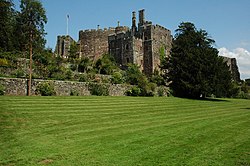 Berkeley Castle | |
| Location | |
| Grid reference: | ST685989 |
| Location: | 51°41’17"N, 2°27’25"W |
| Village: | Berkeley |
| History | |
| Information | |
| Owned by: | Berkeley family |
| Website: | Berkeley Castle |
Berkeley Castle (historically sometimes spelt Berkley Castle) is a castle in the town of Berkeley, Gloucestershire. The castle's origins date back to the 11th century and it has been designated as a Grade-I listed building.[1]
The castle has remained within the Berkeley family since they reconstructed it in the 12th century, except for a period of royal ownership by the Tudors. It is traditionally believed to be the scene of the murder of King Edward II in 1327.[2] </ref>[3]
Construction
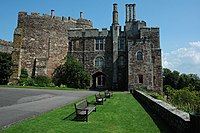
The first castle at Berkeley was a motte-and-bailey, built around 1067 by William FitzOsbern shortly after the Conquest.[4] This was subsequently held by three generations of the first Berkeley family, all called Roger de Berkeley, and rebuilt by them in the first half of the 12th century.[5] The last Roger de Berkeley was dispossessed in 1152 for withholding his allegiance from the House of Plantagenet during the conflict of The Anarchy, and the feudal barony of Berkeley was then granted to Robert Fitzharding, a wealthy burgess of Bristol and supporter of the Plantagenets. He was the founder of the Berkeley family which still holds the castle.[4][6][7][8]
In 1153–54, Fitzharding received a royal charter from King Henry II giving him permission to rebuild the castle,[8] with the aim of defending the Bristol – Gloucester Road, the Severn estuary, and the Welsh border. Fitzharding built the circular shell keep during 1153–56, probably on the site of the former motte. The building of the curtain wall followed, probably during 1160–90 by Robert and then by his son Maurice.[4][8]
Much of the rest of the castle is 14th century and was built for Thomas de Berkeley, 3rd Baron Berkeley: Thorpe's Tower, to the north of the keep, the inner gatehouse to its southwest, and other buildings of the inner bailey.[4]
Murder of Edward II
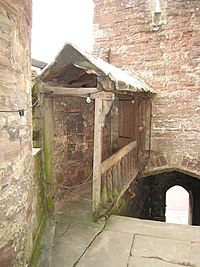
The castle was ransacked in 1326 by the forces of Hugh Despenser, the favourite of Edward II. Then in 1327, Edward was deposed by his wife Queen Isabella and her ally and lover Roger Mortimer, and placed in the joint custody of Thomas de Berkeley and his brother-in-law John Maltravers. They brought Edward to Berkeley Castle, and held him there for five months from April to September. During that time a band of Edward's supporters attacked, entered the castle and rescued him, only for him to be recaptured soon afterwards. It is possible that his captors then moved him around between several castles to make further rescue more difficult, before returning him to Berkeley Castle in September.[9]:115–126 Some commentators of a romantic frame of mind have claimed that Edward's escape was actually successful, and that someone else was later murdered in his place.[3][9]:224-5
Edward was reputedly murdered there on September 21, 1327 by unknown means, although popular stories of a red hot iron or suffocation persist.[3] The cell where he is supposed to have been imprisoned and murdered can still be seen, along with the adjacent 36-foot deep dungeon,[1] which supposedly echoes the events of the murder every year on September 21.[10]
The account given to Parliament at the time was simply that Edward had met with a fatal accident. The body was embalmed and remained lying in state at Berkeley for a month, in the Chapel of St John within the castle keep, before Thomas de Berkeley escorted it to Gloucester Abbey for burial.[4][9]:133-8 Thomas was later charged with being an accessory to the murder, but his defence was that it was carried out by the agents of Roger Mortimer while he was away from the castle, and in 1337 he was cleared of all charges.[9]:164-6
Later history
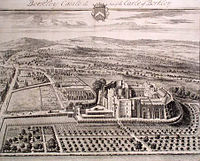
In the 14th century, the Great Hall was given a new roof and it is here the last court jester in England, Dickie Pearce, died after falling from the Minstrels' gallery. His tomb is in St Mary's churchyard which stands besides the castle. Adjoining the Great Hall is one of two of the original chapels, which includes painted wooden vaulted ceilings and a biblical passage, written in Norman French. This room also contains an illustrated vellum book of plainsong that was used in rites, before the family converted to Protestantism in the 16th century.
During the Civil War, the castle still held sufficient significance for it to be captured in 1645 by Colonel Thomas Rainsborough, for the Parliamentarian side and after a siege which saw cannon being fired at point blank range from the adjacent church roof of Saint Mary the Virgin, the Royal garrison surrendered. As was usual, the walls were left breached after this siege but the Berkeley family were allowed to retain ownership on condition that they never repaired the damage to the Keep and Outer Bailey, still enforced today by the original Act of Parliament drawn up at the time; according to Pevsner,[11] the breach is partially filled by a subsequent 'modern' rebuild, but this only amounts to a low garden wall, to stop people falling 28' from the Keep Garden, the original Castle's "motte".
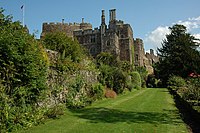
In the early 20th century Randal Thomas Mowbray Berkeley, 8th Earl of Berkeley, repaired and remodelled parts of the castle and added a new porch in the same Gothic style as the rest of the building. One change included an Art Nouveau take on a mediæval bedroom.
The castle is surrounded by terraced gardens, including Elizabeth I's bowling green and a pine that is reputed to have been grown from a cutting taken from a tree at the Battle of Culloden in 1746.
Modern times
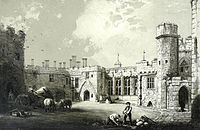
The castle is the oldest continuously occupied castle in Britain after the royal fortresses of the Tower of London and Windsor Castle, and the oldest to be continuously owned and occupied by the same family. It contains an antique four-poster bed that has been identified as the piece of furniture that has remained in continuous use by the same family the longest in the United Kingdom.[12] The Berkeley family divide their time between the Castle and their other home, Spetchley Park, just outside Worcester, which has been in the family's ownership since 1606.
With most areas open to the public since 1997, the private apartments occupy about 15% of the building and the rest is managed by the Berkeley Castle Charitable Trust. A restoration appeal was launched in 2006 to raise £5.5 million needed to renovate and restore the Norman building.[13]
Miscellany
Two ships of the Royal Navy have been named Berkeley Castle after the castle,[14] as has a Great Western locomotive.[15]
The castle was used for many scenes for the BBC children's television series The Ghost Hunter and the first televised version of The Other Boleyn Girl.[16]
Outside links
| ("Wikimedia Commons" has material about Berkeley Castle) |
- Berkeley Castle
- Berkeley Castle history 1
- Berkeley Castle history 2
- Flickr images tagged Berkeley Castle
- Berkeley Castle review and photo gallery on SoGlos.com
- Saint Mary the Virgin
References
- ↑ 1.0 1.1 National Heritage List 1340692: Berkeley Castle
- ↑ Kingsley, Nicholas (2001). The Country Houses of Gloucestershire, Vol.1 1500-1660. Chichester: Phillimore. pp. 51–54. ISBN 1-86077-124-6.
- ↑ 3.0 3.1 3.2 Sumption, Jonathan (5 April 2003). "Plotting the past". London: The Guardian. http://www.guardian.co.uk/books/2003/apr/05/featuresreviews.guardianreview8. Retrieved 25 August 2010.
- ↑ 4.0 4.1 4.2 4.3 4.4 Verey, David; Brooks, Alan (2002). Pevsner Architectural Guide, Gloucestershire 2: The Vale and The Forest of Dean. New Haven: Yale University Press. pp. 176–178. ISBN 0-300-09733-6.
- ↑ Pine, L.G. (1972). The New Extinct Peerage 1884-1971. London: Heraldry Today. pp. 25–26. ISBN 0-900455-23-3.
- ↑ Sivier, David (2002). Anglo-Saxon and Norman Bristol. Stroud, Gloucestershire: Tempus. pp. 75–76. ISBN 0-7524-2533-1.
- ↑ Bettey, Joseph (2000). Rogan, John. ed. Bristol Cathedral: History and Architecture. Charleston: Tempus. pp. 15–19. ISBN 0-7524-1482-8.
- ↑ 8.0 8.1 8.2 Burke (1999). Burke's Peerage and Baronetage, Vol.1. Switzerland: Burke's Peerage. p. 254. ISBN 2-940085-02-1.
- ↑ 9.0 9.1 9.2 9.3 Doherty, Paul (2003). Isabella and the Strange Death of Edward II. London: Robinson. ISBN 1-84119-843-9.
- ↑ Brandon, David; Brooke, Alan (31 October 2009). "The most haunted places in Britain". London: The Guardian. http://www.guardian.co.uk/lifeandstyle/2009/oct/31/most-haunted-places-britain. Retrieved 25 August 2010.
- ↑ Nikolaus Pevsner: The Buildings of England: Gloucestershire 2: The Vale & Forest of Dean, 1970; 2002 Penguin Books ISBN 978-0-300-09733-7
- ↑ Ben Rankin, "Bed that dates back to mediæval times is oldest still in use in Britain", Daily Mirror, 6 March 2013. Retrieved 6 March 2013.
- ↑ "Donate". Berkeley Castle. http://www.berkeley-castle.com/donate.html. Retrieved 20 October 2012.
- ↑ Template:Colledge
- ↑ Daniel, John. "4073 'Castle' class". The Great Western Archive. http://www.greatwestern.org.uk/m_in_cas.htm. Retrieved 27 December 2008.
- ↑ "Scope | Issue 16| Film Reviews". Scope.nottingham.ac.uk. http://www.scope.nottingham.ac.uk/filmreview.php?issue=16&id=1206. Retrieved 20 October 2012.
